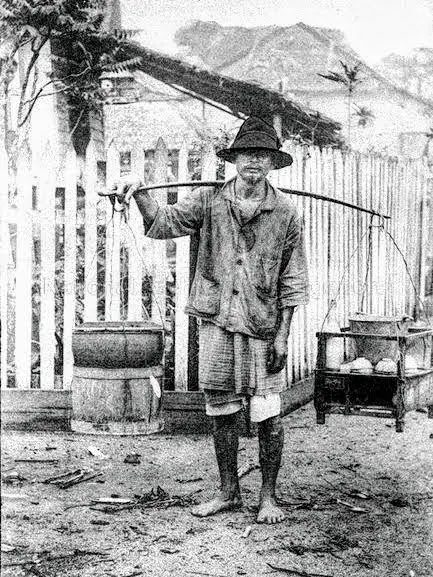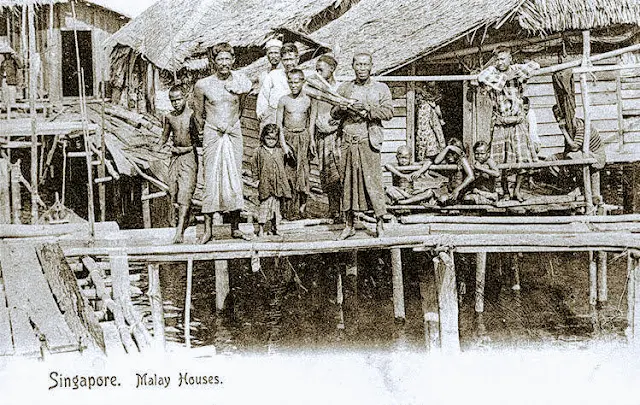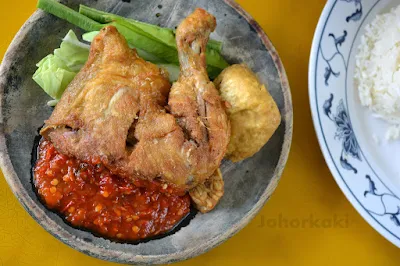Brief History of Indonesia
Pre-historic Indonesians are Austroasiatic and Austronesian peoples from the north, arriving around 2,000 BC.
Around 600 AD settlers from India established kingdoms in Indonesia - the most powerful was the Hindu-Buddhist Srivijaya empire which ruled Sumatra and most of Java from 650 - 1377.
The Buddhist Shailendra empire ruled central Java from 650 to 1025. One of their legacies is the Borobudur temple (still the largest Buddhist structure in the world) built in the seventh century.
The next great Indonesian empire was the Hindu Majapahit which ruled nearly the entire archipelago from 1293 - 1527.
Islam first arrived with Muslim traders and missionaries in Sumatra in the 1300s and gradually spread across the entire archipelago. Today, 87% of Indonesians are Muslim while less than 2% are Hindu.
One of the theories on the origin of sate (satay) attributes the dish to Muslim missionaries in the 1300s. During Adha or Day of Sacrifice, goats or cows were offered. Its meat was cut into small pieces, skewered on a thin bamboo stick and grilled over charcoal (like Middle Eastern kebabs). The person who made the first sate (satay) was a bamboo craftsman named Satah, hence the name sate (satay). Today, sate is ubiquitous across the archipelago and one of Indonesia's national dishes.
Satay man in Singapore in 1907. Up till the 1970s, hawkers plied their trade on a bamboo pole with two baskets across their shoulders. Their whole stall complete with kitchen, pantry, and kitchen sink were on their shoulders. One basket contained the charcoal stove and satay. The other basket another stove to keep the pot of peanut sauce warm, and water to wash bowls. Often, the hawkers carried a couple of stools for himself and his customers.
Portuguese seeking to control the East - West trade routes conquered Malacca in 1511. Then came the Dutch and English in search of spices such as nutmeg and cloves. The Dutch and English battled over spices and outposts in the archipelago. The Dutch prevailed - first, the Dutch East India Company and then the government of the Netherlands ruled Indonesia from 1610 to 1949.
The Portuguese brought chili pepper from central America to Malacca and Indonesia. Today, chili peppers play a central role in Indonesian cuisine. Sambal (chili relish) is synonymous with Indonesian food. There's a different sambal for almost every dish, so there're more than 300 types of sambal in Indonesian cuisine.
Indonesians in Singapore
The first immigrants to Singapore were an Indonesian prince named Sang Nila Utama and his followers in 1299. At that time, there were two powerful kingdoms in Indonesia. The rising Majapahit empire in Java and the waning Srivijaya empire based in Palembang, Sumatra.
With the Srivijaya empire crumbling, its princes set out to establish fiefdoms of their own. Sang Nila Utama, a Srivijayan prince decided to set up the kingdom of Singapura after spotting a fierce animal on the island which he was told was a lion - a good omen in Srivijayan culture.
The kingdom of Singapura, a thriving seaport, lasted 99 years and five generations until it was razed by the Majapahit empire in 1398. The last king of Singapore, Parameswara fled to Malacca where he established the Malacca sultanate. Meanwhile, Singapura was abandoned.
Malacca prospered as a major trading hub between China and India / Arabia. The good times ended in 1511 when the Portuguese invaded. The last sultan of Malacca, Mahmud Shah fled south to Johor where he established the Johor-Riau-Lingga sultanate. In 1641, the Johor-Riau-Lingga sultanate supported the Dutch to expel the Portuguese from Malacca.
Singapore was within the domain of the Johor-Riau-Lingga sultanate but languished as a backwater i.e. it was the proverbial fishing village populated mainly by Orang Laut fishermen (and pirates) and a Temenggong (a noble responsible for security under the Johor-Riau-Lingga sultanate).
In 1819, the neglected island caught the eye of Raffles who was looking for a foothold between the East-West trade routes for the British East India Company. Raffles signed the Singapore Treaty with Sultan Hussein and the Temenggong of Johor in 1819 allowing the British to operate a trading post at the Singapore River.
When Raffles arrived in Singapore in 1819, there were about 1,000 Malays. Most were Orang Laut or sea nomads (named after the river where they lived ) - 500 Orang Kallang, 200 Orang Seletar, 200 Orang Gelam (Singapore river). The remainder were the Temenggong and his followers (who came from Pulau Bulan off Batam island in 1811). (There were also some Chinese working in gambier / pepper plantations on the island.)
With his vision to make Singapore a major trading hub, Raffles opened the gates to traders, tradesmen, and all the labour he needed to operate a thriving seaport. The wheels of immigration from Indonesia, Malaya, China and India began to turn.
In Singapore, Malays as an ethnic group includes persons from the Malay peninsula (Malaya) or Indonesia such as Riau Malays, Javanese, Boyanese, Bugis, Minangkabau, etc. In 1824, through migration, ethnic Malays comprised 60% of Singapore's population. Today, Malays make up slightly more than 13% of Singapore's population.
Riau Malays
Roti Jala or net bread is inspired by the fishing nets Riau Malays used to catch fish. The batter is made with wheat flour, egg, coconut milk and turmeric which gives it its signature yellow colour. The batter is poured through a perforated hopper and fried on a flat griddle. Traditionally, the thick, watery batter is simply dribbled from the fingers onto the griddle to make the net pattern. It is then rolled. Roti jala is eaten with chicken or mutton curry dip.
Bugis
Javanese
Javanese from the Indonesian island of Java came to Singapore as hawkers, traders, pilgrimage brokers, ironsmiths, gardeners, plantation labourers, etc. Some Javanese were transiting Singapore for their Haj to Mecca. They worked in Singapore to pay for their passage and some settled in Singapore. Many of them settled at Kampong Jawa within Kampong Gelam. By 1931, Javanese numbering over 16,000 made up nearly 25% of Singapore's Malay population. Not surprisingly, Javanese dishes have the most presence among Indonesian cuisine in Singapore.
Rawon is a soup and meat dish from Central / East Java. The signature soup is made by sautéing garlic, shallot, buah keluak, ginger, candlenut, turmeric, and red chili to release their flavours and aromas. This mixture is then added into a soup made by boiling beef bones, and meat. There's also lemongrass, galangal, bay leaf, kaffir lime leaf, etc for more flavour. The black colour of the spicy soup comes from buah keluak. Rawon is enjoyed with boiled rice. It's one of my favourite Indonesian dishes.
Ayam Penyet which literally means "squeezed chicken" is a chicken thigh half cooked in yellow spice mix (mainly turmeric), then deep fried to a golden brown crisp. The fried chicken is smacked with the flat of a chopper or a mallet before serving, hence the name Ayam Penyet. Eaten with a large dollop of sambal which is decisive in how good the rendition is. Served with sides of fried tofu, tempe, raw long beans and cabbage. Eaten with rice and chicken soup.
Goreng Bebek from Central and East Java is deep fried duck eaten with sambal, salad (ulam) and boiled rice. The duck meat is marinated in spices like candlenut, shallot, galangal, peppercorn, coriander seed, etc and cooked by boiling in coconut water with lemongrass, lime leaf, etc. The cooked duck is left to cool and dry before deep frying to a brown-golden crisp. Goreng bebek is crispy outside while relatively moist and tender inside.
Bakso originated from Central and East Java but is ubiquitous across Indonesia. It is meatballs either of beef or chicken in a soupy bowl of yellow noodles or rice vermicelli. Garnished with fried shallot and chopped coriander or spring onion. There's also a "dry" version where the noodles are tossed in aromatic oil and savoury sauce while the soup is served in a separate bowl.
Soto is Indonesian style chicken soup. Whole chicken are boiled in spicy soup with cinnamon, cloves, cardamon, etc. Turmeric feature prominently, hence the yellowish hue. The chicken and soup are eaten with yellow noodles, rice vermicelli or rice cakes (ketupat). Many people spice up their soto with sambal or kicap pedas (spicy soy sauce).
Mee Rebus is the Singapore / Malaysia derivative of Javanese Mie Jawa. It is blanched yellow noodles and bean sprouts drenched in a thick gold colour sauce. The original sauce in Java is made with chicken stock, garlic, shallot, candlenut, pepper, coriander, leek, cabbage, green tomato, etc. There are many variations of the sauce (the soul of the dish). In Singapore, beef stock is used instead, thickened with mashed sweet potato, flavoured with spices such as turmeric, and dressed with dried shrimp (udang geragau). In Singapore, mee rebus is eaten with a dribble of dark soy sauce and cut green chili.
Nasi Goreng or fried rice is boiled rice, cooled then stir fried with oil, kicap manis (soy sauce sweetened with palm sugar) and beaten egg. Shrimp, chicken, beef or mutton may be added. Eaten with sides of fried chicken, fish, egg, satay, and sambal etc.
Nasi Ambeng is a communal dish served on a large platter. At the centre is a mound of boiled white rice and ringed around it are dishes from curry chicken, beef rendang, spicy squid, fried fish, stir fried vegetables, pickled vegetables to even stir fried noodles. There's usually 5 to 7 side dishes but there is no limit on what might be selected for the sides.
An ice cold sweet dessert, cendol is a godsend in Singapore because of our humid and often blistering hot weather. It is "noodles" infused with fragrant pandan juice served in sweet coconut milk further sweetened with palm sugar. Often served with add ons like boiled red beans, attap seed, boiled corn, durian, etc.
Cendol is said to come from the Middle East brought to Java by traders around the 7th century. Known as dawet in East Java, dawet is deeply embedded in Javanese lore and customs. The dessert spread to west Java where it is known as jendol. When Javanese migrated to Singapore (and Malaysia), they brought the dessert with them.
Minangkabau
Minangkabau people came to Singapore from West Sumatra. Many of them came as traders. Minangkabau society is matrilineal i.e. women are head of the house and inheritance is passed down through the women. The men would leave and establish families outside his birth village. Coming to Singapore without their women, Minangkabau men assimilate into other Malay communities. Though Minangkabaus are a minority among Singapore Malays, their cuisine is prominent.
Rendang is the best known Minangkabau dish in Singapore. It is usually made with beef, mutton or chicken. The meat is slow stewed in a curry of coconut milk and spices for a few hours till all the liquid is evaporated. All the flavours and aromas from the coconut milk and spices become infused into the fibres of the meat. When we bite into the piece of rendang, the infused flavours and aromas are released like a perfume.
Rendang is sold as one of the side dishes at nasi padang stalls in hawker centres. Nasi Padang is boiled rice eaten with side dishes in small plates. In Padang (West Sumatra) and across Indonesia, nasi padang stalls / restaurants serve many small plates with the rice to every customer. After the meal, the customer pays only for side dishes eaten. Unused side dishes are served to other customers. (However, in Singapore, you are served only what you have ordered.)
Baweanese or Boyanese
Roti Boyan is a pan fried purse made with single layer dough of wheat flour, butter and egg. The golden brown crisp purse is filled with sautéed chopped or mashed potato, egg, coriander, spring onion and onion filling. There's chili and pepper for those who like some heat in their filling. Roti Boyan is eaten with sambal tumis ikan bilis (chili paste with dried anchovies).
Banjarese
 |
| Geylang Serai Food Centre |
Where do you get your Indonesian food in Singapore?







![The greatest extent of Majapahit influence based on the Nagarakretagama[1] in 1365](https://upload.wikimedia.org/wikipedia/commons/thumb/7/71/Majapahit_Empire.svg/350px-Majapahit_Empire.svg.png)

























No comments:
Post a Comment
All comments submitted with genuine identities are published